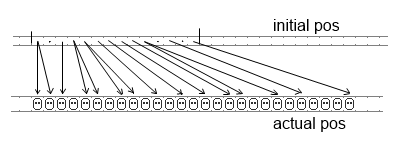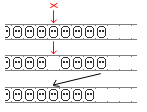|
On Robin Hood hashing
September 13, 2014
Recently I played a bit with Robin Hood hashing, a variant of open addressing
hash table. Open addressing means we store all data (key-value pairs) in one big
array, no linked lists involved. To find a value by key we calculate hash for the key,
map it onto the array index range, and from this initial position we start to wander.
In the simplest case called Linear Probing we just walk right from the initial position
until we find our key or an empty slot which means this key is absent from the table.
If we want to add a new key-value pair we find the initial position similarly and
walk right until an empty slot is found, here the key-value pair gets stored.
Robin Hood hashing is usually described as follows. It's like linear probing,
to add a key we walk right from its initial position (determined by key's hash)
but during the walk we look at hash values of the keys stored in the table
and if we find
a "rich guy", a key whose Distance from Initial Bucket (DIB) a.k.a. Path
from Starting Location (PSL) a.k.a. Probe Count is less than the distance we've
just walked searching, then we swap our new key-value pair with this rich guy
and continue the process of walking right with the intention to find a place
for this guy we just robbed, using the same technique. This approach decreases
number of "poors", i.e. keys living too far from their initial positions and
hence requiring a lot of time to find them.
When our array is large and keys are scarce, and a good hashing function distributed
them evenly so that each key lives where its hash suggests (i.e. at its initial
position) then everything is trivial and there's no difference between linear probing
and Robin Hood. Interesting things start to happen when several keys have the same
initial position (due to hash collisions), and this starts to happen very quickly -
see the Birthday Problem. Clusters start to appear - long runs of consecutive
non-empty array slots.
For the sake of simplicity let's take somewhat exaggerated
and unrealistic case that however allows to get a good intuition of what's happening.
Imagine that when mapping hashes to array index space 200 keys landed onto [0..100]
interval while none landed onto [100..200]. Then in the case of linear probing it
will look like this:

Many keys got lucky to land and stay on their initial positions, but there are also
ones that landed very far from their initial buckets, we need to walk through the whole
cluster to find them.
In the case of Robin Hood hashing it will look like this:

There are very few riches who remained their initial position. But there are
also no very poor guys who require a walk through whole cluster to be found,
we need to walk half the cluster at worst. It means the worst case became twice
shorter and the average walk length got 25% shorter. Also here we can see the
main property of Robin Hood hash table which is not obvious from its usual
descriptions: all keys in the array are sorted by their initial positions.
Because during insertions Robin Hood always favors the poor, the keys with
longer distances from their initial buckets, which means a key with lower
initial position will take the place of a key with higher initial position,
moving it to the right. This understanding allows us to make an important
optimisation: when we rob a rich guy making him search for a new place to live,
all the ones to the right already have higher (or equal) initial positions, so
we don't have to compute and compare them all when walking right, we can just shift
right the whole part of cluster from this position to its end. Same result, less
work. Another important optimisation: when we search for a key we don't have to
walk from its initial position to the end of whole cluster. When, during the walk,
we find a key whose initial position is greater than the one we're looking for,
it means our key is not present in the table, we can give up the search. This
makes searching for non-existing elements significantly faster than in linear
probing.
Deletion. In the case of linear probing we find the key we want to delete and
move to its slot the last value from the cluster, making it shorter.

In the case of Robin Hood hashing we act differently: we mark the slot as deleted,
leaving a tombstone that says "Mr. X lived here, his hash value was H".

This is done to preserve the sorting of keys' starting positions. If we leave the
deleted slot empty then when inserting some other key it may occupy this slot
even if its initial position is greater than initial position of some key to the right
of it, making that key impossible to be found. We also cannot move a key from the end
of cluster to the deleted slot, this will break the sorting again. What we can do however
is shift left the whole part of cluster from the deleted slot to the end of cluster.
This is called "backward shift deletion" and some people called it an optimisation,
because it reduces mean PSL and hence makes the search for keys faster.
But the people who offered it did not bother to measure actual times. In reality
it's not an optimisation, it makes things worse and slower. First, because the shifting
takes significant time. And second, it makes insertion much slower. Because when we
insert a key we shift right not the whole cluster but only a part till the first
tombstone.

From insertion's point of view each deleted element divides the cluster in two
parts, making it effectively twice shorter, reducing amount of data to be shifted
when inserting. So tombstones make both insertion and deletion much faster than
the backward shifting "optimisation". Of course, it's really a trade off between
search speed and insertion & deletion speed, so the right choice depends on
which operation is more important to you.
After making
my own implementation
(in D) I started testing it with random values of different types and discovered
that when the key type is string my hash table works abysmally slow. My first guess
was that hash function for strings was slow or maybe comparing string keys was slow.
But no, that was not the case. On my random strings the hash function used by D for
strings was not uniform enough, which caused clusters to appear and grow very quickly.
And since complexity of one hash table operation is proportional to cluster size,
time of n insertions grew as O(n2). For comparison I took an implementation
of linear probing open addressing hash table from the
vibe.d project. It showed absolutely the same problem:
when keys were strings it was up to 50 times slower than D's built-in associative
arrays which are hash tables with separate chaining (i.e. linked lists for each bucket).
To fight this problem I added to my Robin Hood hashes monitoring of maximum cluster
size so that when it exceeds some threshold the table grows even if its load factor
is not very high yet. Of course we can't do it too often, or the table will eat all our
RAM, so another parameter limits its growth so that the load factor doesn't fall below
certain threshold when table grows.
Benchmark results turned out not very conclusive.
In some cases one hash table is better, in some - another.
Here's a table with
times in milliseconds. Four implementations were measured: D's associative arrays
(chaining based hash table), linear probing from vibe.d and two Robin Hood hashes,
one where hashes are stored separately from the key-value pairs and one where
they are stored together. Turns out in most cases it's better to store hashes
separately.
For each combination of key-value types following operations were benchmarked:
- add_remove: a list of operations was generated consisting of n1 insertions,
n2 deletions, n3 insertions, n4 deletions etc. of random values where n1,n2,... are also
random numbers, total of 400 000 operations. Then all 4 hash table implementations
executed this same list of operations.
- make_histo: for an array of 10 000 000 random values a histogram was calculated,
i.e. counts of occurences for each value. So just insertions and updates. Again, one
same input array for all hash table implementations. Value type is int.
- read_histo: for the same array of 10 000 000 keys, values (counts) from the
histogram created by previous task were read for a simple operation, so this test
is for lookups.
Each test was performed 10-20 times, time measurements averaged after filtering out
obviously wrong ones where GC turned on and performed its cycle. Classes and structs
used in the tests were taken in two forms: one with my own toHash and comparison
operations defined and one with default operations autogenerated by the compiler.
tags: programming
|